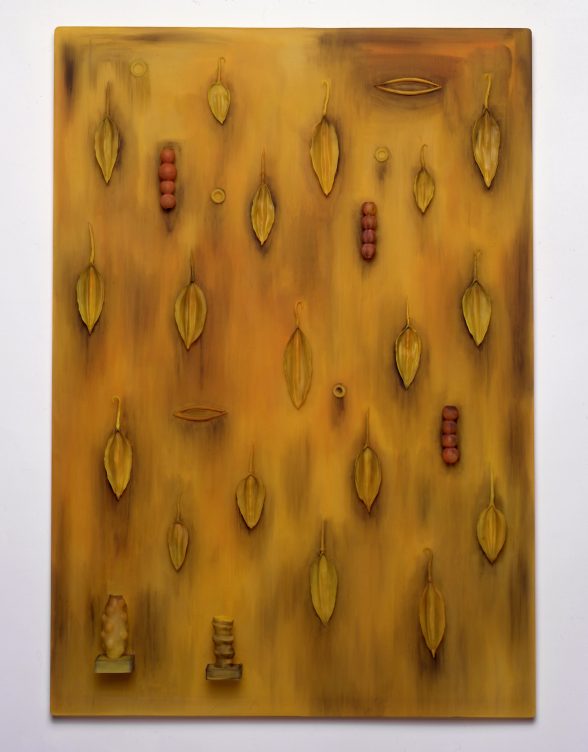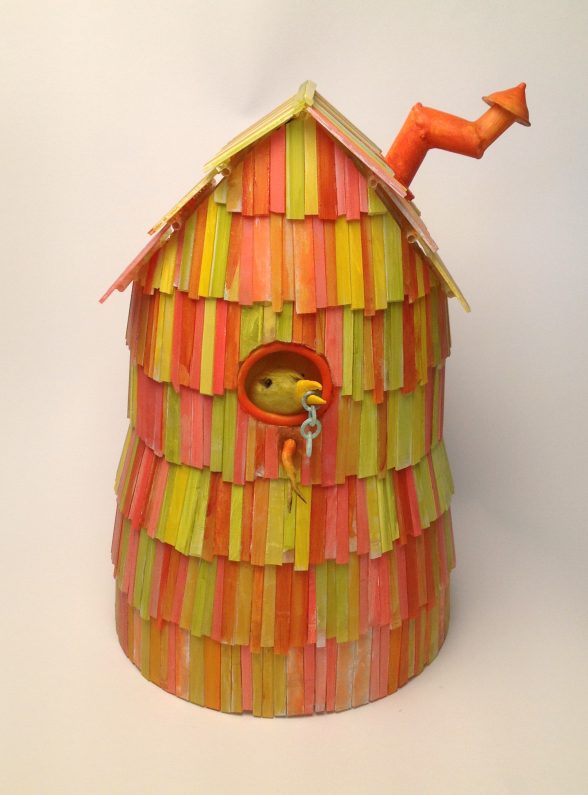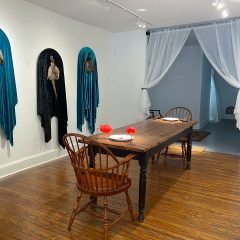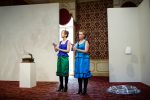Jay Musler got bit by the glass bug when he was young, and, 40 years later he’s a master glass artist whose works populate museums around the world. Born in 1949 in Sacramento, CA, Musler is a second generation Studio Glass Movement artist whose sandblasted, painted and novel takes on glass art changed the direction of this unusual art form. Musler dropped in on my Paris studio for a conversation about glass after a conference on the subject in Murano, Italy.
In the early 1970s, Musler travelled across the San Francisco Bay to Oakland to take a class at the California College of the Arts with Marvin Lipofsky, a first generation an innovator of The American Studio Glass Movement, who had constructed a furnace using special insulation bricks designed to melt glass at about 2,000 Fahrenheit. The class used Manville glass marbles and poured them into the furnace.
Making his first piece – a small bottle
At CCA, Musler’s first piece as a student was, a small bottle…. “Nothing special, but I thought it was the greatest thing,” he said. But the process was tricky and a bit dangerous.
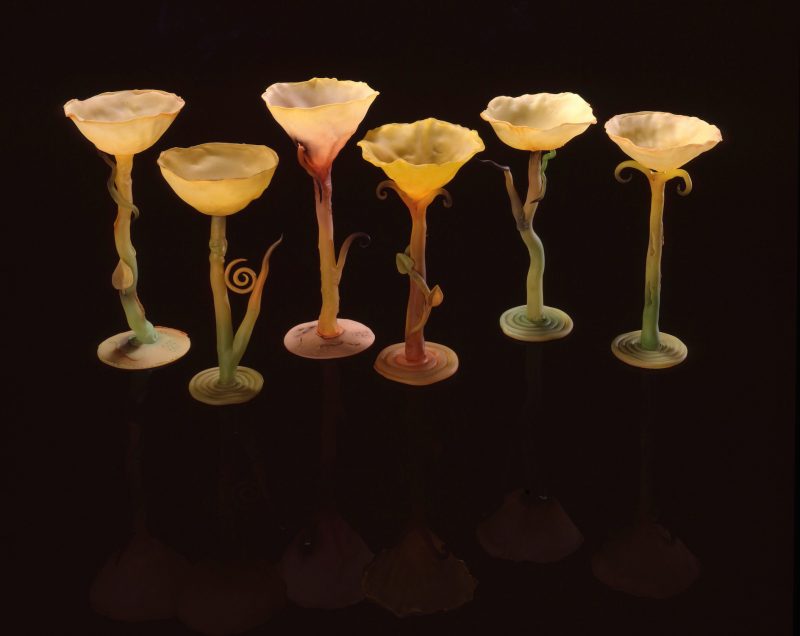
“You had to grab the molten glass from the furnace with a long pipe, then wrap it around – like taffy. Once you had it under control, you’d roll it on a marver, a steel table. You could then blow into the pipe, creating a bubble by turning it and blowing into it at the same time. It takes a while, but you soon develop a rhythm and coordination.”
Musler cited Dick Marquis, Bob Ness, Paula Barton and Lipofsky as key influences. These artists were among the first generation innovators of the mid-Century American Studio Glass Movement. [Ed. Note: Dale Chihuly, most closely associated with contemporary American glass, was taught by this generation.]
A little background on the Studio Glass Movement
That Movement began in 1962 with a collaboration between chemist Dominick Labin and ceramics teacher Harvey Littleton as they experimented with melting glass with the goal of blowing it and making art. They offered workshops with access to a small furnace at the Toledo Museum of Art. There they began blowing glass into unusual and non-functional art works. One of their students, Marvin Lipofsky, created a UC Berkeley glass art program in 1964. Lipofsky would become both friend and mentor to Musler.
Musler’s switch from functional to non-functional glass
After Musler’s modest efforts producing bottles, glasses and a range of objects at CCA, Musler got an eight-dollar-an-hour job making wine glasses from molds in a San Francisco factory. But he eventually tired of working for other people, reproducing the same piece again and again.
“In college I met some artists who started a studio in Marin, just north of San Francisco,” he recalled. Musler and these artist colleagues built their own furnace and followed the trend of non-functional glass art and objects by Littleton and Lipofsky and a do-it-yourself work ethic. Making their own glass, for example.
“Instead of using marbles, we decided to make our own glass – something softer, cleaner. We bought the special virgin white sand used on golf courses – 99% iron free. The results are translucent, clear.” “You could use sand from the beach, but then you’d have a Coke-bottle green finish,” he explained. “(Glass from) recycling isn’t very good either.”
Musler soon saw glass blowing as a means towards making art, making sculpture. “There were some artists at UC Berkeley who were doing things with glass that picked up from the industry but went further. You could see a range of ‘pop art’ works – from fetuses to pickles.”
“In Marin, we went into production on our own works, first creating clear and white glass that we would roll into different colored enamels to produce greens, yellows, oranges and blues,” explained Musler. “The process also involved using metal molds, with their insides coated with cork, which we would wet before we poured the molten glass in.”
Musler’s funky surreal aesthetic riffs on functional objects
While the Studio Glass Movement artists made strange objects that were lyrical and intimate, Musler, took a funkier and sometimes more surreal turn to create objects that were “not exactly beautiful, but gruddy.” Muster’s approach has been to create an assemblage of glass that is rich in color and texture, often painted and saturated with light.
The focus of Musler’s non-functional pieces played off of common objects normally associated with glass. His bowls for example, were beautiful but bizarre; his “Cityscape” bowls, for example had actual skylines cut into their upper edges!
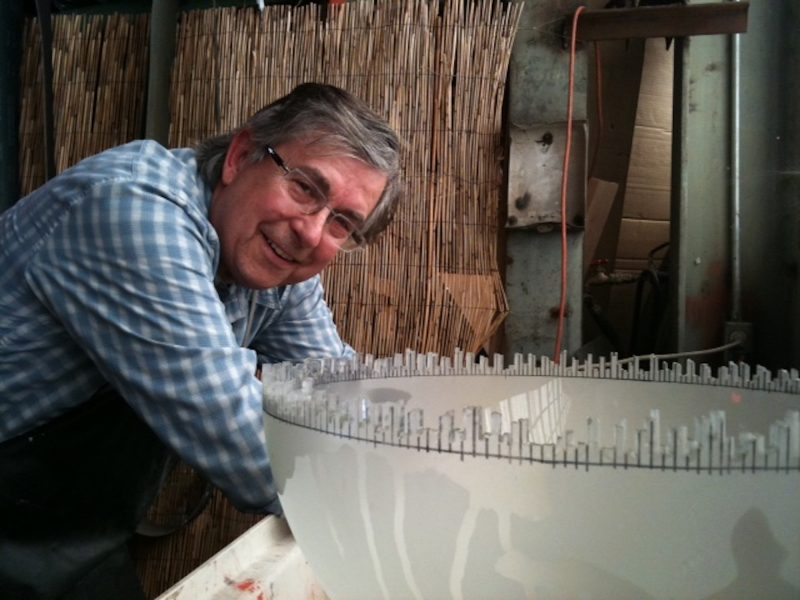
Over the last 40 years, Musler’s work has attracted global attention. His glass artworks are in dozens of collections worldwide, including the Hokkaido Museum of Glass in Sapporo, Japan. His signature “Cityscapes” – shown in Japan brought collectors out in droves. “My works are not functional in any way,” he said, though they can oddly mirror real world objects.
His yellow mosaic teapot, “Beehive” (1994), combines both glass and paint, and riffs on both teapots and a notion of bees and honeycombs. It is part of a fanciful collection of teapots at the Kamm Teapot Foundation in Los Angeles. Musler cites a “cartoon aesthetic” he absorbed from underground comic artists like Bill Griffin and Robert Crumb. as influencing his direction.
His ‘Goblet Series’ plays on the notion of wine glasses, but veers off into metaphors of plants, chains and surreal fictions sprouting from a chapter in Alice in Wonderland. “Little Darling” (2014) is a goblet carrying a pail of flowers; “Kiss Me” (2011) features sandblasted glass, glass chains and “nails” that appear like cactus needles punctuating the work.
Recent work in masks and the Jay Musler Gallery
In the last few years Musler has created an expansive series of masks based upon travels to Central America and Mexico, and strange, latticed wall pieces that are carefully fused glass dowels painted in oil. Oftentimes glass chains hang off them, and eye-like objects float on their faces, as in “Let There Be Light” (2011). Others, like “Deep in Space” (2006), echo folk art with small wheels, and idiosyncratic objects fused to them. These works are heavy and terribly fragile.
Musler has produced a vast oeuvre of glassworks in more than 40 years in the studio. He also operates the Jay Musler Gallery which, as you might imagine, specializes in glass art…
This summer Musler and his gallery, Jay Musler Gallery will focus an exhibition on Marvin Lipofsky, “World Without Borders; The Art of Marvin Lipofsky.” Opening : Friday, Aug. 17, 5-8 pm, Jay Musler Gallery, 1250 Missouri St., #211, San Francisco, CA. Open by appointment thereafter.


